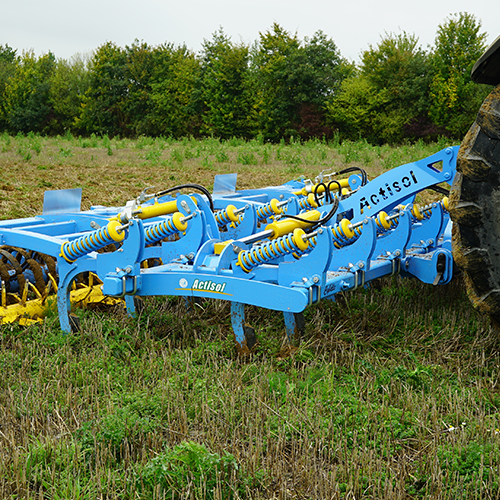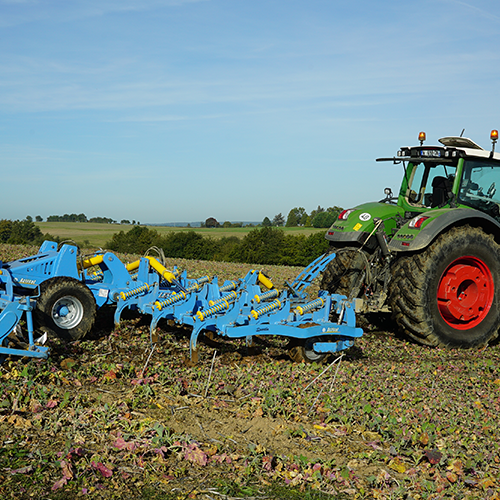Showing all 5 results
Actisol stubble worker: prepare for sowing
What is stubble working?
Stubble working is considered a form of shallow tillage. It is defined as the action of destroying and burying stubble or straw in the first centimetres of the soil after a harvest and creating stale seedbeds while preparing the soil for the next crop.
Benefits of stubble working
Stubble working cleans the plot and adds organic matter to the soil through the decomposition of buried debris. This action improves the distribution of liming materials and the quantity of manure in the soil if any is spread over the stubble.
Stale seedbeds can also be created to trigger the germination of weed seeds in order to destroy them later. It reduces the likelihood of pest eggs, such as slug eggs, hatching through dehydration from exposure to air.
Actisol crackers facilitate root development by fragmenting compacted horizons. Crops are strengthened through the provision of conditions for deep root development. This technique offers real benefits for your soil and your crops.
Finally, stubble working prepares the seedbed for future crops by levelling the plot and loosening the soil.
At Actisol, we favour shallow stubble work which limits evapotranspiration by destroying existing plants. It also reduces surface capillarity. Organic residues of low thermal conductivity must remain on the surface to insulate the soil and reduce evaporation.
The various types of stubble cultivator
There are five main families of stubble cultivators featuring different machinery:
Toothed tools
Tine stubble cultivators often have wide spacings between the teeth and large clearance under the frame. This family comprises four different types of tools: heavy cultivator (chisels), machinery with rigid straight tines with or without springs, harrow, and vibra-cultivator.
Self-powered tools
Featuring discs, this type of machinery performs shallow work with low energy consumption. Two main categories stand out in this range: tools with revolving discs or bladed rotors.
Ploughs
Featuring a narrower body than standard ploughs, field stubble ploughs keep the same mouldboard principle but less high, to turn the earth over and bury the stubble.
Disc tools
This type of stubble cultivator performs shallow work at higher speeds than cultivators with penetrating teeth. They cut the ground to a depth depending on the machinery’s weight. The discs rotate to bury the stubble. The volume of soil moved depends on the size of the disc and its curve. This category includes cover crop sprayers and independent disc stubble cultivators.
Mixed tools
Some machinery has both teeth and discs. The teeth loosen the earth deeply and the discs bury stubble and straw.
Choosing the right stubble cultivator
The choice of a stubble cultivator mainly depends on the power of the tractor that will be towing it. The nature of the soil must also be taken into account. It is not uncommon for a farm to have different types of soil in its various fields.
The kind of crops planted on the plot must also be considered. A perennial does not have the same root system as an annual. Taproots, rhizomes, or even fasciculated roots are not destroyed in the same way or at the same depth.
The volume of residue to be buried is also important to consider, as is the quality of earth crumbling after using the tool in order to avoid erosion or crusting. The goal being to achieve homogeneous burial of material.
Stubble working with Actisol
Actisol has two stubble cultivators in its range.
Tooth stubble cultivators
The Actisol cracking tooth accommodates several types of extirpation blades at its base, often called scalping blades. Mounted on a twin- or three-beam frame, such as the Demeter, the Cybelle, or the Spartéa, they offer a big overlap to clear the plot of weeds.
In this configuration, the cracking tooth has a major advantage: its size. It maintains the stubble working level while keeping tillage flat to keep residues on the surface.
The Demeter, the first in the Actisol range, is equipped with a fixed reinforced frame with (depending on the model) two or three rows of teeth available for stubble working, from 5 to 8 cm. Its working width is 2.5 m to 4.2 m.
This family of machinery is designed to equip all traction powers. For stubble working, in a three-beam frame, soil circulation is improved. Each tooth is mounted on a system of flanges to obtain the necessary clearance.
It features a tandem roller system with independent adjustment. The first roller (mixteur) promotes straw integration into the soil during stubble working. The second roller, adapted according soil type, presses the soil down to retain the moisture in it and level the plot.
Equipped to accommodate a 3-row harrow behind the roller, the latter promotes the distribution of stubble and refines the work.
The Cybelle, which came out in the 90s, is based on the same principle as the Demeter with two rows of teeth. However, its reinforced frame folds. It was designed to meet the requirements of a greater work output but with a height and width suitable for road transport. Its working width is 4 m to 5 m.
It is also equipped to accommodate a 3-row harrow behind the press roller. The Spartéa also features Actisol teeth distributed over 3 rows for a high soil flow. With a width of up to 6 metres, it offers the highest work output in the Actisol toothed tool range. From an agronomic point of view, it has the same qualities as the Demeter and the Cybelle, but with a coupling frame.
The Demeter, Cybelle, and Spartéa are versatile tools, suitable for stubble working, mechanical weeding, and cracking thanks to a range of wear parts specifically designed for each job. The geometry, design, and materials chosen for the wear parts also reduce fossil fuel consumption. With good wear resistance, this contributes to controlled operating expenses.
Star disc stubble cultivator
The Stell’air, a star disc mulcher developed in 2019, is a tool that is self-powered by the movement of the tractor. It allows you to achieve a fine soil thanks to the star discs called ‘stars’. These comprise a disc fitted with 12 twisted blades that penetrate the ground and create a jet of earth thanks to their shape and angle.
This machinery is considered a shallow stubble cultivator which works at depths of 2 to 3 cm depending on the land. It meets the objective of producing a high density of weed germination while maintaining soil protection by the presence of residue on the surface. Going over the weeds a few days after emergence will destroy this stale seedbed, while continuing shallow work before weed root structure develops.
Stell’air creates a mulch on the surface that protects the soil from crusting. This mulch improves soil fertility by enriching the surface layer with organic matter. This organic matter on the surface fosters the development of organisms which will find the ideal conditions in which to decompose the material and return it to the soil.
It is also possible to couple the Stell’Air with press roller to a 3-row harrow. The distribution of the stubble is thus optimal and mineralisation at its maximum.
The Stell’Air is multi-purpose machinery. It can be used for stubble working, sowing, mulching, and destroying plant cover. With a single piece of machinery, Actisol offers its user complete plant cover management respecting agronomic rules.
Whether with a toothed or star Actisol, the Actisol range is constantly developing to offer tools that meet your needs.
Which stubble cultivator should you choose from our two ranges ?
Teeth stubble cultivators ? Disc stubble cultivators? Now that you’re familiar with the two types of equipment we develop in this range, which one should you choose ? It’s important to bear in mind that these two major families operate in very different ways, and that each has its own specific advantages.
The teeth cultivator is more versatile, as it can work on different horizons. It will help to maintain a good structure and obtain a soil that functions vertically. Disc harrows have the advantage of being able to process large quantities of material at high work rates. Its versatility lies in the complete management of plant cover.
Want to find out more? Read our blog post: which stubble worker should you choose for your crops
Whether it’s an Actisol with teeth or discs, the Actisol range evolves every day to offer tools to match your needs, thanks in particular to our range of stubble cultivator.







